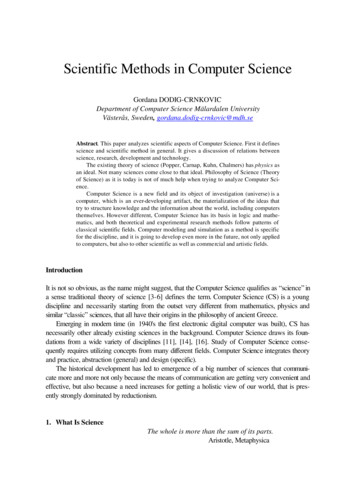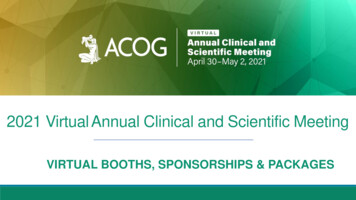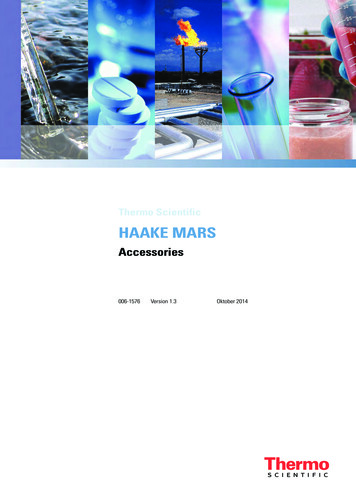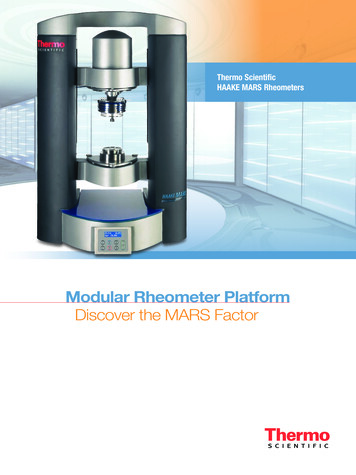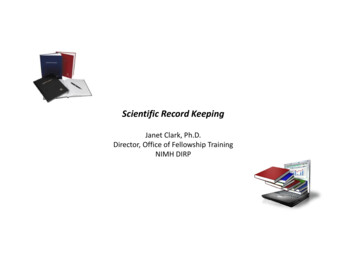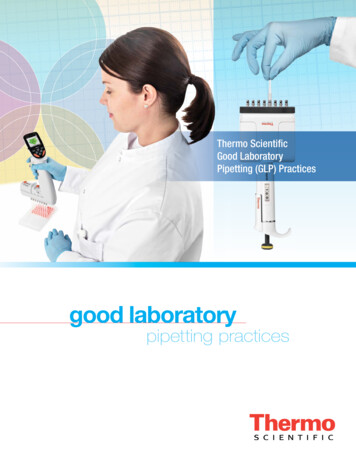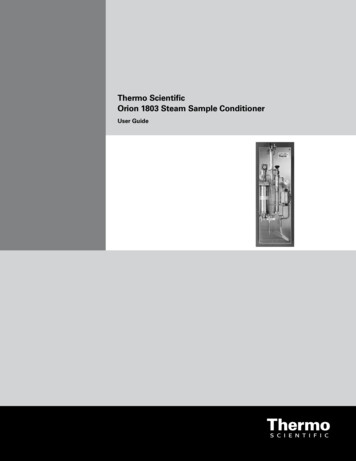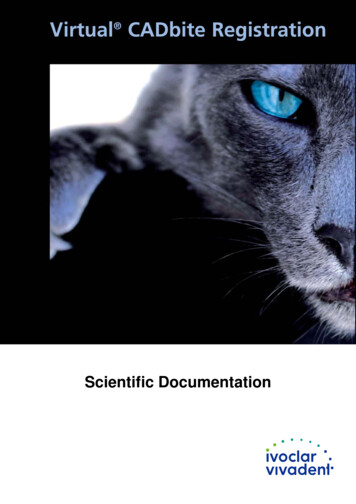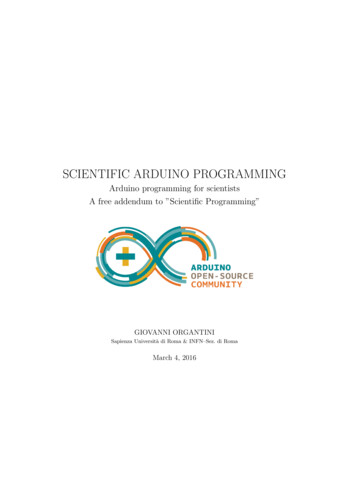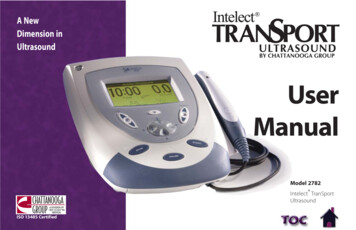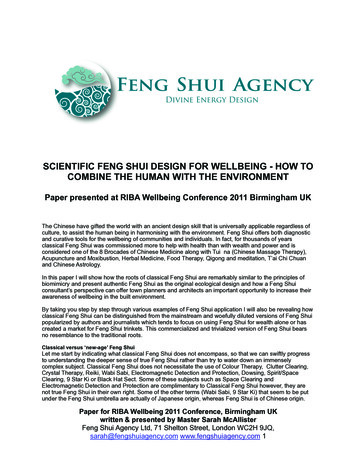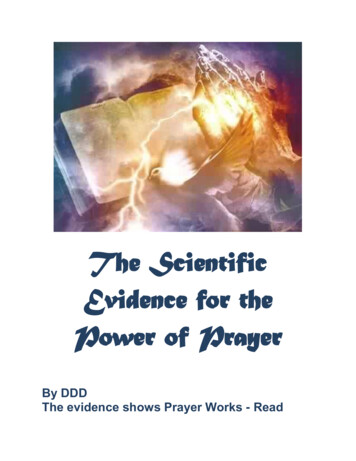
Transcription
The ScientificEvidence for thePower of PrayerBy DDDThe evidence shows Prayer Works - Read
Effects of Prayeron ImmuneSystemDoes prayer really help theimmune system to work?Yes. Evidence exists for the healing power of prayer. According to Dr. Barbara Joseph in"My Healing From Breast Cancer," her inspiring book, "If we allow ourselves the belief inthe power of prayer and pray for our highest good in the way that comes most naturally tous and with the utmost compassion for ourselves, we can support our healing."[1]The real force of prayer in preventing and overcoming disease are described in severalexcellent books:[2-4] "Healing Words, The Power of Prayer and the Practice of Medicine" by L. Dossey, M.D. "Prayer is Good Medicine: How to Reap the Healing Benefits of Prayer" by L. Dossey,M.D. "The Faith Factor" by D. MathewsClinical studies have demonstrated that people who pray are:[4] Less likely to get sick
Better able to cope mentally and emotionally with their illness More likely to recover from surgery More likely to recover from illnessAlso, evidence exists for the power of prayer to maintain and improve the function of theimmune system. Chemical connections have been identified between molecules producedby the central nervous system and cells of the immune system.[5] Astrocytes, a type of cellin the brain, can produce interleukin-1 (IL-1), a cytokine that affects immune reactions.Furthermore, lymphocytes, a type of white blood cell, contain receptors for manychemicals synthesized by the central nervous system.Prayer and the psychological factors involved, including suggestion, expectation, anxietyreduction, conditioning, and the hope and will to live may have a positive placebo effect innourishing the function of the immune system.[6] Clinical trials of the effects ofchemotherapeutic drugs on cancers and determination of side effects show that placeboeffects occur in the control groups of patients (i.e, those receiving no active drug).Moreover, the relaxing, altered consciousness, and spiritual effects of meditation andprayer and the resulting inward sense of peace can strengthen the immune system and thebody in general.[5-7] According to Harold Koenig, Director of the Center for the Study ofReligion/Spirituality, Duke University, when prayer uplifts or calms the spirit of people,fewer stress-induced (sometimes termed "fight-or-flight") hormones are produced by theadrenal glands.Meditation and prayer can:[5-7] Decrease stress-induced hormones Reduce pre-surgery anxiety Lower the risk of development of various serious diseases Help the immune system to functionIn addition, many recent studies have shown that patients with serious diseases who areprayed for by others actually heal better and faster than do those who are not prayed forby others. Praying for the healing of others is a form of an alternative medicine methodknown as "distance healing." In prayer by others (termed intercessory prayer), attitudes ofprayerfulness and holiness and feelings of empathy, caring, and compassion encouragehealing.[5, 7]Studies show that prayer by people concentrating on the healing of either cells grown inthe laboratory or animals with certain ill conditions can reduce the growth rate ofleukemia cells in culture, decrease the size of tumors in mice, and speed wound healing inanimals.[6, 7] A small, double-blind (meaning that neither the patients nor the doctorsknew who was receiving the distance "treatment") clinical study of patients with
advanced AIDS demonstrated that distance healing reduced the number of new AIDSdefining illnesses, severity of disease, outpatient visits to doctors, number and days ofhospitalizations, and mood.[8, 9]Some doctors feel that better recovery of the patients could occur if the doctors prayedwith their patients prior to and following operations or the administration of powerfulmedications.[5] Because of the positive research on the effects of prayer and these beliefsabout the value of prayer in the healing process, certain medical schools in the U.S. areoffering classes in faith and medicine.However, we should not assume that just our prayer and/or prayer by others will eitherkeep us from getting sick or make us well. Dr. Dossey observes that, "We shouldunderstand that prayer does have an impact, but it can’t save us from death or guaranteewe won’t get sick."[2, 3]As with other alternative medicine approaches, meditation and prayer can help usempower our minds with positive energy, aid in the body’s recovery, improve quality oflife, and improve outcome. Dr. Dossey recommends, ".don’t wait for the results of moredouble-blind studies to pray. We can stand to have more extraneous prayer in this worldof ours."[2, 3]REFERENCES1. B. Joseph. My Healing From Breast Cancer." 1996. New Canaan, Connecticut: KeatsPublishing.2. L. Dossey, "Healing Words, the Power of Prayer and the Practice of Medicine." 1993. SanFrancisco: Harper.3. L. Dossey: Prayer is Good Medicine: How to Reap the Healing Benefits of Prayer. 1996.San Francisco: Harper.4. D. Mathews, "The Faith Factor."5. Distance healing really works. Jewish Link. Accessed atwww.jewishhealing.com/healing really works.html.6. S. Barrett. Psychoneuroimmunology — the bridge between science and spirit. In "SilverThreads," edited by B. Kane, J. Millay, and D. Brown. 1993. Praeger.7. Prayer & spirituality: The proof that prayer works. Holistic-online.com. Accessed athttp://1stholistic.com/prayer/hol prayer proof.htm.8. F Sicher, et al. A randomized double-blind study of the effect of distant healing in apopulation with advanced AIDS: Report of a small scale study. "Western Journal ofMedicine." 1998; 169(9): 356-63.9. R.A. Anderson. Psychoneuroimmunoendocrinology review and commentary."Townsend Letter for Doctors and Patients." 04/2002.
Prayer and Medical ScienceThis Commentary originally appeared in Archives of Internal Medicineby Larry Dossey, MD"It is fatal to dismiss antagonistic doctrines, supported by any body of evidence, assimply wrong." Alfred North Whitehead, 1948 1THE RANDOMIZED, controlled trial by Harris et al2 on the effects of remoteintercessory prayer on outcomes of patients admitted to a coronary care unit evokedseveral comments from physicians.Several respondents implied that the attempt to study the remote effects of prayer iswrong in principle. This is because, according to Dr Sandweiss,3 science deals withfacts, not "miracles." Yet, if events occur in controlled laboratory studies, as suggestedby evidence cited below, these happenings presumably follow natural law and are notconsidered miraculous.We should be cautious in calling events miraculous or mystical, because thesubsequent course of history may reveal that these terms reflect little more than ourown ignorance. For example, when Newton invoked the notion of universal gravity in the17th century to explain his observations, he was charged by his contemporaries withsurrendering to mysticism, as prayer researchers are often accused today.As philosopher Eugene Mills4 describes, "[Newton's critics] disapproved of his failure toexplain why bodies behaved in accordance with his laws, or how distant bodies couldact on one another . . . This sort of worry no longer bothers us, but not because wehave answered it."Today we are as baffled by the remote effects of prayer as Newton's critics were by thedistant effects of gravity. But, just as the dispute over gravity gradually abated, thedebate surrounding intercessory prayer may also diminish with time, even though ourignorance about the mechanism involved may remain.Dr Van der Does5 dismisses the effects of intercessory prayer because they would beindistinguishable empirically from the effects of clairvoyance and telepathy, which heimplies are nonsense. (He presumably means not clairvoyance or telepathy, which areforms of anomalous cognition, but psychokinesis, the anomalous perturbation of distantevents.) However, there is considerable evidence that neither telepathy norpsychokinesis is nonsense,6 in which case the indistinguishability between prayer andpsychokinesis would not invalidate prayer.Dr Sandweiss3 also refers dismissively to psychokinesis, apparently unaware of theevidence favoring this phenomenon. For example, in Foundations of Physics, one ofphysics' most prestigious journals, Radin and Nelson7 reported a meta-analysis of 832studies from 68 investigators that involved the distant influence of humanconsciousness on microelectronic systems.
They found the results to be "robust and repeatable." In their opinion, "Unless criticswant to allege wholesale collusion among more than sixty experimenters or suggest amethodological artifact common to . . . hundred[s of] experiments conducted over nearlythree decades, there is no escaping the conclusion that [these] effects are indeedpossible."While these hundreds of studies do not involve actual prayer, they nonetheless dealwith whether human intention can, in principle, affect the physical world at a distance.In recent years, researchers have also studied the effects of mental efforts to changebiological systems.8 Scores of controlled studies have examined the effects ofintentions, often expressed through prayer, on biochemical reactions in vitro, on therecovery rate of animals from anesthesia, on the growth rates of tumors and the rate ofwound healing in animals, on the rate of hemolysis of red blood cells in vitro, and on thereplication rates of microorganisms in test tubes.Testing prayer in lower organisms makes sense for the same reason we test drugs innonhumans. We share physiological similarities with animals and bacteria; if prayeraffects them, it may affect us as well.These studies are too often ignored, even by researchers interested in the effects ofintercessory prayer in humans. This is unfortunate because many of these studies9have been done with great precision and have been replicated by different investigatorsin different laboratories. They make up the basic or bench science underlying theobjective study of prayer.Dr Sandweiss3 says that since we know that prayer cannot operate remotely, taking thispossibility seriously requires us to "suspend natural law," which results in"pseudoscientific mischief." But, as there is no agreement among scientists about whichnatural laws govern consciousness, it is imprudent to declare which laws might beviolated and what mischief might result.Several outstanding scholars have emphasized our appalling ignorance about the basicnature of consciousness. John Searle,10 one of the most distinguished philosophers inthe field of consciousness, has said, "At our present state of the investigation ofconsciousness, we don't know how it works and we need to try all kinds of differentideas."Philosopher Jerry A. Fodor11 has observed, "Nobody has the slightest idea howanything material could be conscious. Nobody even knows what it would be like to havethe slightest idea about how anything material could be conscious. So much for thephilosophy of consciousness."Recently Sir John Maddox,12 the former editor of Nature, soberly stated, "Thecatalogue of our ignorance must . . . include the understanding of the human brain . . .What consciousness consists of . . . is . . . a puzzle.
Despite the marvelous success of neuroscience in the past century . . ., we seem as faraway from understanding . . . as we were a century ago . . . The most importantdiscoveries of the next 50 years are likely to be ones of which we cannot now evenconceive."If these observers are anywhere near the truth, we should be hesitant to declareemphatically what the mind can and cannot do.Dr Sandweiss3 states that Harris et al have taken "a P value out of context" and thattheir P value is "out of control." He implies that the beliefs and practices of physiciansdepend strongly on statistically valid studies and that P3D.04 is too weak to justify achange in "current theories." Do P values determine what we physicians believe andhow we practice medicine?This is a noble sentiment, but evidence suggests we are not as objective as DrSandweiss implies. Yale surgeon and author Sherwin B. Nuland13 states, "Unlike otherareas in which fads come and go, medical styles [of practice] are meant to be supportedby irrefutable evidence. That assumption is so far off the mark that the term 'medicalscience' is practically an oxymoron."Referring to a 1978 report by the Congressional Office of Technology Assessment,14Nuland states, "no more than 15 percent of medical interventions are supported byreliable scientific evidence."Richard Smith,15 editor of the British Medical Journal, agrees, stating, "only about 15%of medical interventions are supported by solid scientific evidence. . . . This is partlybecause only 1% of the articles in medical journals are scientifically sound and partlybecause many treatments have not been assessed at all."And David A. Grimes16 of the University of California-San Francisco School of Medicinestates, "much, if not most, of contemporary medical practice still lacks a scientificfoundation."These observations suggest that a double standard is perhaps being applied to prayerresearch, according to which levels of proof are demanded that may not be required ofconventional therapies-the "rubber ruler," the raising of the bar, the ever-lengtheningplaying field.17Do serious scientists really believe that the effects of intercessory prayer are fantasy, asseveral letter writers imply? No doubt some do.But in a recent survey18 of the spiritual beliefs of American scientists, 39% of biologists,physicists, and mathematicians said they not only believed in God, but in a god whoanswers prayers.The highest rate of belief was found in the field of mathematics, which is generallyconsidered the most precise of all the sciences. Many distinguished scientists favorprayer. A long list of individuals, including Nobelists, who have been cordial to
consciousness-related events, such as distant, intercessory prayer, has beenassembled by philosopher DavidGriffin.19Should the empirical study of intercessory prayer be abandoned, as several letterwriters imply? More than a century ago, a similar debate took place among Britishscientists about telepathy, clairvoyance, and psychokinesis, which, like prayer, presumethat consciousness can operate remotely.Nobelist Sir William Crookes (1832-1919), the discoverer of thallium, contrasted his ownapproach with that of his fellow physicist Michael Faraday (1791-1867), famous for hiswork in electricity and magnetism. Crookes20 stated:Faraday says, 'Before we proceed to consider any question involving physicalprinciples, we should set out with clear ideas of the naturally possible and impossible.'But this appears like reasoning in a circle: we are to investigate nothing till we know it tobe possible, whilst we cannot say what is impossible, outside pure mathematics, till weknow everything. In the present case I prefer to enter upon the enquiry with nopreconceived notions whatever as to what can or cannot be.The spirit of open inquiry would seem to validate Crookes' stance. Scientific puzzles donot solve themselves unaided. How are the mysteries of consciousness and prayer tobe resolved unless researchers take a stab at them?Dr Sandweiss3 suggests that the lack of an accepted theory underlying intercessoryprayer diminishes the respectability of this area of investigation. In the history ofmedicine, however, we have often tolerated ignorance of mechanism and absence oftheory. Examples include the use of aspirin, colchicine, and quinine, as well as the useof citrus fruits in scurvy, as Harris et al point out. The mechanisms of action of mostgeneral anesthetics are still a mystery, yet that does not preclude their use.While it is true that there is no generally accepted theory for the remote actions ofconsciousness, many mathematicians, physicists, and biological and cognitive scientistsare currently offering hypotheses about how these events may happen.Hypotheses that are compatible with the distant effects of intercessory prayer havebeen advanced by Nobel physicist Brian Josephson,21 physicist Amit Goswami22 ofthe University of Oregon's Institute of Theoretical Science, mathematician and cognitivescientist David J. Chalmers,23, 24 systems theorist Ervin Laszlo,25 mathematician C. J.S. Clarke,26 and many other respected scholars.27These models of consciousness generally advocate a nonlocal view of the mind-a viewin which consciousness is not localized or confined to specific points in space (such asthe brain) or time.Levin28 has developed a theoretical model of how prayer may heal that takes several ofthese hypotheses into account. I have described the implications of a nonlocal model of
consciousness for medicine.29 Dr Hammerschmidt30 suggests that Harris et al are"putting God to the test" in their study. Are tests of prayer blasphemous, and are prayerresearchers heretics?I have found that investigators in this area approach their subject with reverence andrespect; indeed, I have not found a single exception. They seem to epitomize the viewof chemist Robert Boyle,31 the 17th-century author of Boyle's Law, who suggested thatexperimental scientists are "priests of nature" and that science is so sacred thatscientists should carry out their experiments on Sundays as part of their Sabbathworship.Dr Goldstein32 is "concerned with the potential effect of [the Harris et al] study and itspublication on the reputation of hospitals involved and on the integrity of health careorganizations in general." The reputation of any healing institution is precious andshould be protected, but the suggestion that a hospital's reputation will be endangeredby the indiscriminate use of prayer is exceedingly hypothetical.It is more likely that the widespread application of prayer will enhance the reputation ofhealing institutions, in view of the facts that nearly 80% of Americans believe in thepower of prayer to improve the course of illness,33 and nearly 70% of physicians reportreligious inquiries for counseling on terminal illness34 yet only 10% of physicians everinquire about patients' spiritual practices or beliefs.35In a survey36 of hospitalized patients, three fourths said they believed their physicianshould be concerned about their spiritual welfare, and one half said they believed theirphysician should not only pray for them but with them. It is unlikely that prayer couldthreaten the reputation of hospitals to the extent of many conventional therapies.A recent meta-analysis of prospective studies by Lazarou et al37 found that more than100,000 persons die in US hospitals each year from adverse drug reactions, "makingthese reactions between the fourth and sixth leading cause of death." A recent survey38of American adults asked about their concerns before checking into a hospital or otherhealth care facility.Sixty-one percent were "very concerned" about being given the wrong medicine, 58%about the cost of treatment, 58% about the negative interaction of multiple drugs, 56%about medical procedure complications, 53% about receiving correct information aboutmedications, and 50% about contracting an infection during their stay. Concerns aboutbeing indiscriminately prayed for did not make the list.Dr Pande39 suggests that the analogy by Harris et al with James Lind's discovery of thehealing potential of citrus fruits in scurvy is inappropriate. A person deprived of vitaminC will develop scurvy, whereas a person deprived of prayer or believing in God'sexistence, he states, will not become unhealthy.There is evidence to the contrary. Scores of studies40, 41 suggest that, on average,individuals deprived of religious meaning live shorter, less healthy lives than people whofollow some sort of religious path, which almost always includes prayer.
Drs Sloan and Bagiella42 question whether Harris et al are justified in suggesting thatintercessory prayer be considered an adjunct to conventional medical practice, sincethere is no consensus in medicine about this controversial intervention.There is indeed no consensus, but whether this is because of a lack of data orignorance of current evidence is a valid question.43 Certainly further investigation ofintercessory prayer is warranted, but we need not wait until all the answers are in beforeemploying prayer adjunctively. This view is represented by Lancet editor RichardHorton44 in his "precautionary principle."Horton states, "We must act on facts and on the most accurate interpretation of them,using the best information. That does not mean that we must sit back until we have 100percent evidence about everything. When the . . . health of the individual is at stake . . .we should be prepared to take action to diminish those risks even when the scientificknowledge is not conclusive."Although skepticism is an invaluable component of scientific progress, it can shade intoa type of dogmatic materialism that excludes intercessory prayer in principle,45 as whenNewton's critics condemned universal gravity as occult nonsense without weighing theevidence.Both true believers and committed disbelievers in intercessory prayer might heed theview of mathematical physicist and philosopher Alfred North Whitehead,46 whocoauthored Principia Mathematica with Bertrand Russell:" The Universe is vast. Nothing is more curious than the self-satisfied dogmatism withwhich mankind at each period of its history cherishes the delusion of the finality of itsexisting modes of knowledge. Sceptics and believers are all alike. At this momentscientists and sceptics are the leading dogmatists. Advance in detail is admitted:fundamental novelty is barred. This dogmatic common sense is the death ofphilosophical adventure. The Universe is vast."Larry Dossey, MDSanta Fe, NM
In the Preface of his powerful book, Healing Words – The Power of Prayer and the Practice ofMedicine, Dr. Larry Dossey writes,
“For many years, I’d ignored prayer. I considered it an arbitrary, optional frill that simply wasnot in the same league as drugs and surgery. I had in fact tried to escapespiritual or religiousinfluences in healing, fancying myself a scientific physician.”Thankfully Dr. Dossey’s studies brought him in contact with scientific evidence of prayer’shealing power. Upon discovering a lone scientific study supporting the power of prayer, hebegan to probe scientific research for further confirmation and found an enormous body ofproof – over one hundred experiments, many conducted under stringent laboratory conditions.A majority of these studies “showed that prayer brings about significant changes in a variety ofliving beings.” This revelation led Dr. Dossey to embark on ten years of research into therelationship between prayer and healing. The result is Healing Words – a book that has becomea classic discourse of the power of prayer in healing.Dr. Dossey cites convincing studies and case histories that demonstrate how prayer can helpheal a number of ailments including high blood pressure, asthma, heart attacks, headaches, andanxiety. He provided an example in an interview titled “A Conversation About the Future ofMedicine”:“In 1998, Dr. Elisabeth Targ and her colleagues at California Pacific Medical Center in SanFrancisco, conducted a controlled, double-blind study of the effects of ‘distant healing,’ orprayer, on patients with advanced AIDS. Those patients receiving prayer survived in greaternumbers, got sick less often, and recovered faster than those not receiving prayer. Prayer, inthis study, looked like a medical breakthrough.”In addition to providing numerous examples of how prayer can contribute to healing, Dr.Dossey book examines various methods of prayer and outlines practical guidelines for how wecan all use our own minds and our connection with the divine, regardless of our religiousinclination, to help gain and maintain optimum health.
Dr. Dossey’s groundbreaking work has helped create a wave of interest in the topic. Accordingto his interview, Dr. Dossey can’t keep up with invitations to speak about these issues atmedical schools and hospitals. Even Oprahinterviewed him about the topic. I am greatlyencouraged by this increasing amount of attention being placed prayer and healing. And Iagree with the author that Healing Words points toward “a medicine that is both effective andmore humane, a medicine that works better and feels better.”This entry was posted in Mindfulness, Spirituality, Stress Management, Uncategorized andtagged Dr. Elisabeth Targ,Dr. Larry Dossey, Healing Words, prayer and healing. Bookmarkthe permalink.Larry Dossey In "Healing Words: The Power ofPrayer.June 26, 1994 By Cheryl Lavin.Larry DosseyIn "Healing Words: The Power of Prayer and the Practice of Medicine"(HarperSanFrancisco), Dr. Larry Dossey says prayers can really heal.Q: What proof is there that prayers work?A: There are more than 130 studies showing that if someone adopts a loving, caring attitudetoward another living organism, human or not, that organism becomes healthier.Q: For instance?A: In 1988 a cardiologist divided 400 heart patients into two groups. One group had theirfirst names given to prayer groups. Neither the patients nor the physicians knew who werebeing prayed for. Ten months later, the prayed-for group had fewer deaths, and no one in itwas on a mechanical ventilator, versus 12 in the non-prayed-for group.Q: Does prayer work as well if you pray for yourself?A: Almost all the studies have been done using an intercessionary because it's hard toseparate the effect of prayer from positive thinking and the placebo effect.
Q: Can you cite a study using non-humans?A: Ten test tubes of identical bacteria were divided in two. One group had people praying forits speedy growth, and it did grow faster than the other group.Q: Why would whatever higher power that hears prayers answer such a seemingly foolishrequest as, "Please make these five test tubes of bacteria grow faster"?A: Maybe that power is saying, "You ought to listen up, and here's the proof."Q: What exactly is prayer?A: My definition is very, very broad: communication with the Absolute. For some, thiscommunication is words said out loud; for others, it's silent, even beyond words. And forsome, the Absolute is the Christian God; for others, it's the universe.Q: What is the most important factor in having a prayer answered?A: The degree of the love, sincerity and compassion of the one praying.Q: Do you have to believe in an absolute power for prayer to work?A: Yes. If you don't, I don't know how you can consider it a prayer.
Title:Large Scale Study of the Safety and Efficacyof the SCIO DeviceChief Editor:Prof William Nelson M.D. IMUNEThe Centro Ricerche, University of Venice Padova, ItalyEdited and Validated By IMUNE Medical Staff:Mezei Iosif MD, RomaniaSarca Ovidiu MD, RomaniaIgor Cetojevic MD, CyprusMatthias Heiliger M.D. Germany/SwitzerlandKlara Hilf M.D. HungaryAnna Maria Cako M.D. HungaryDebbie Drake M.D. CanadaBacean Aurel MD RomaniaConsultant:International Ethics, Lebedei 58,Oradea, RomaniaJohn Kelsey Phd, ND N.Z. Eng,Gage Tarrant LBT, C.H.T, USA, Somlea Livia RomaniaRichard Atkinson MCSP, Physical Therapist, West Yorkshire EnglandDeveloped By:The Centro Ricerche of Prof. William Nelson University of Venice Padova, Italy
This study was performed in the field by practicing Biofeedback technicians. Datawas collected and the study supervised by the Ethics International InstitutionalReview Board of Romania. The Data analysis and study presentation is done Bythe The Centro Ricerche, University of Venice Padova, Italy Ethics International, 2007.Abstract:A global and momentous research project was developed for the last three years. The SCIOdevice is a Universal Electro-Physiological device used for stress reduction and patient treatment. Over2,200 qualified biofeedback therapists joined our Ethics Committee study to evaluate how stressreduction using the SCIO device could help a wide variety of diseases.The device and thus the study has insignificant risk. There was a staff of medical doctors whodesigned and supervised the study. This study started in 2004 as an attempt to show the world thevalidation of being a SCIO therapist.Over 98,000 patients gave informed consent and participated in the study. The study wouldconclusively prove safety and efficacy of the SCIO Device. With over 60% of these patients havingmultiple visits. There were over 275,000 patient visits. With a total record of the SCIO patientinformation, therapy parameters and reactivity data. No names of patients were recorded forconfidentiality.Two of the 2,200 plus therapists were given blank devices that were completely visually thesame but were none functional. These two blind therapists were then given 35 patients each. This wasto evaluate the double blind component of the placebo effect as compared to the device. Thus thestudied groups were a placebo group, a subspace group, and an attached harness group.This is just the first study in a long task of analysis in truly break down the data totally. Thisstudy verifies the safety and efficacy of the SCIO device. There were small effects seen in the placebogroup, larger effects in the subspace, and astounding effects in the real harness group.Large Scale Study of the Safety andEfficacy of the SCIO DeviceAbstract:A global and momentous research project was developed for the last two years. The SCIO deviceis a Universal Electro-Physiological device used for stress reduction and patient treatment. Over 2,200qualified biofeedback therapists joined our Ethics Committee study to evaluate how stress reductionusing the SCIO device could help a wide variety of diseases.
The SCIO device and thus the study has insignificant risk. There was a staff of medical doctorswho designed and supervised the study.Over 98,000 patients gave informed consent and participated in the stu
The real force of prayer in preventing and overcoming disease are described in several excellent books:[2-4] "Healing Words, The Power of Prayer and the Practice of Medicine" by L. Dossey, M.D. "Prayer is Good Medicine: How to Reap the Healing Benefits of Prayer
